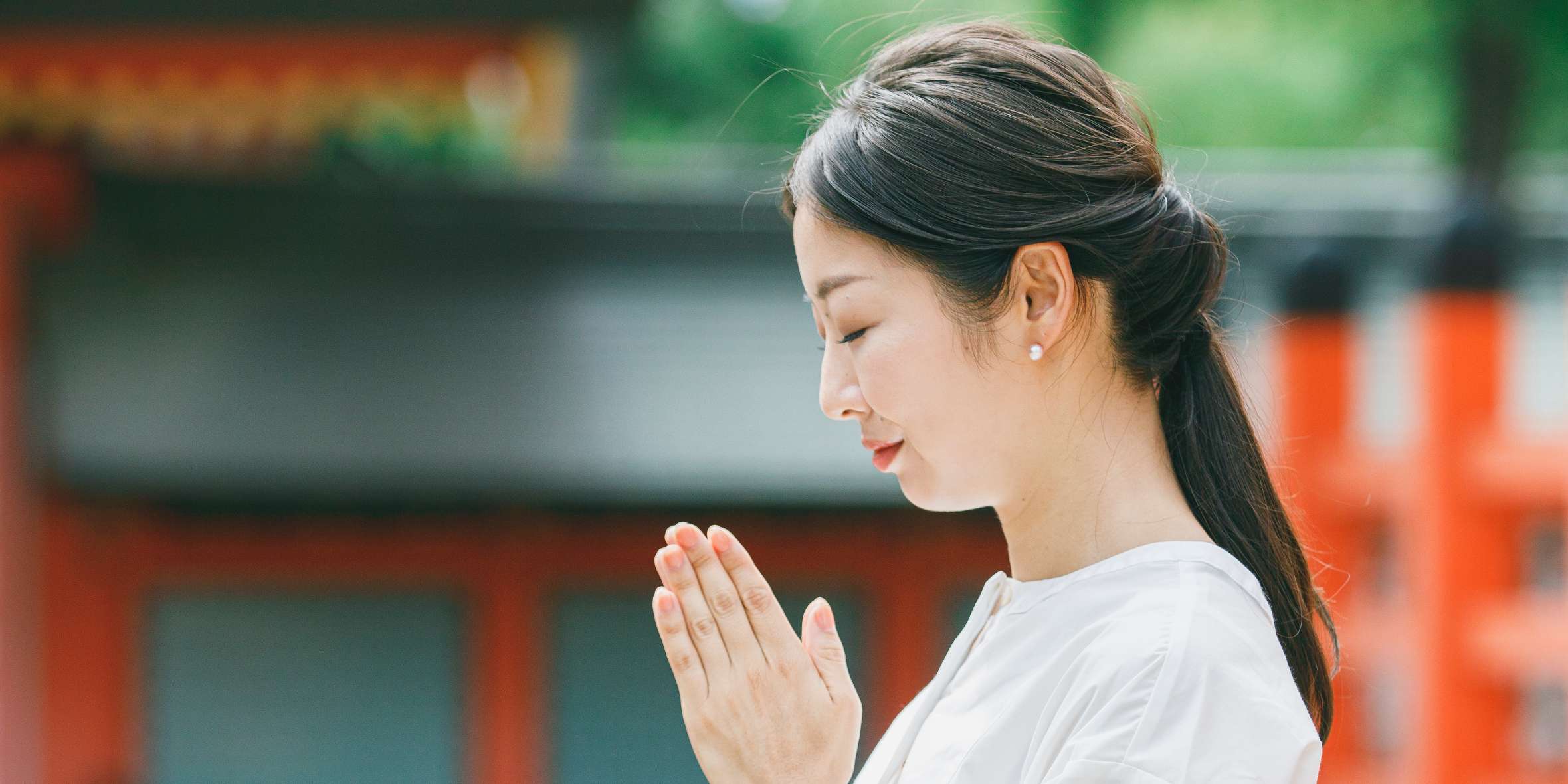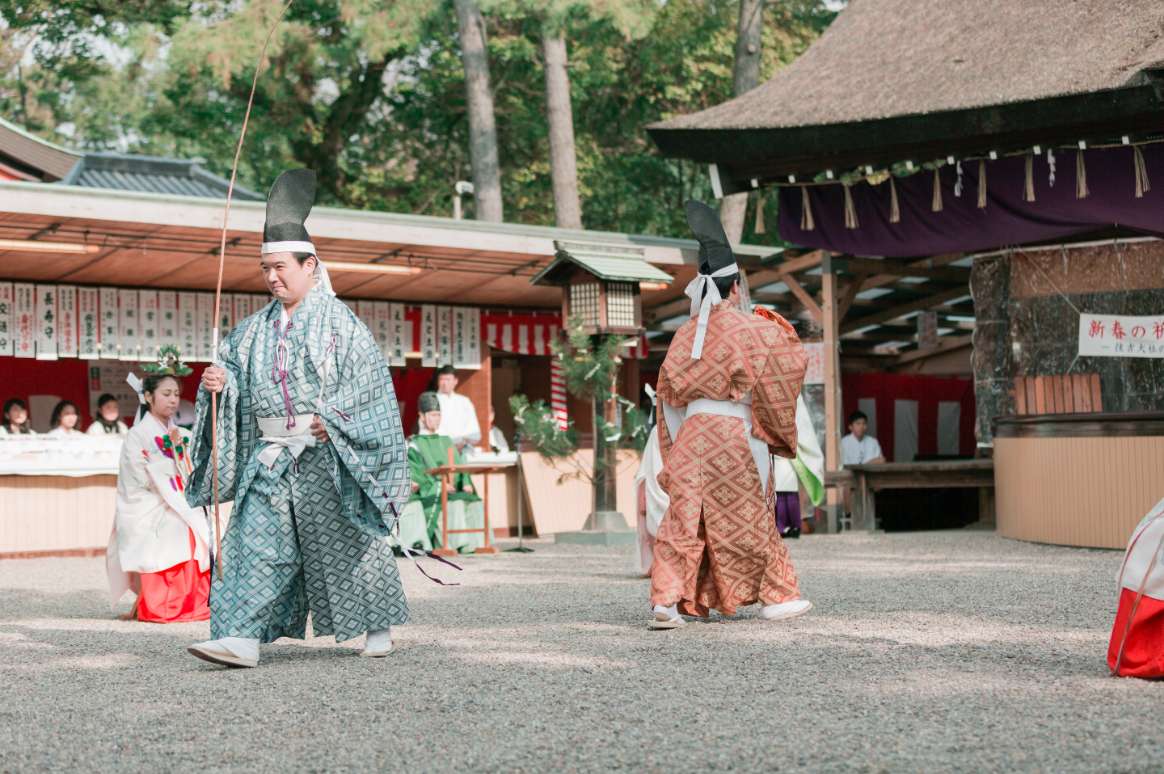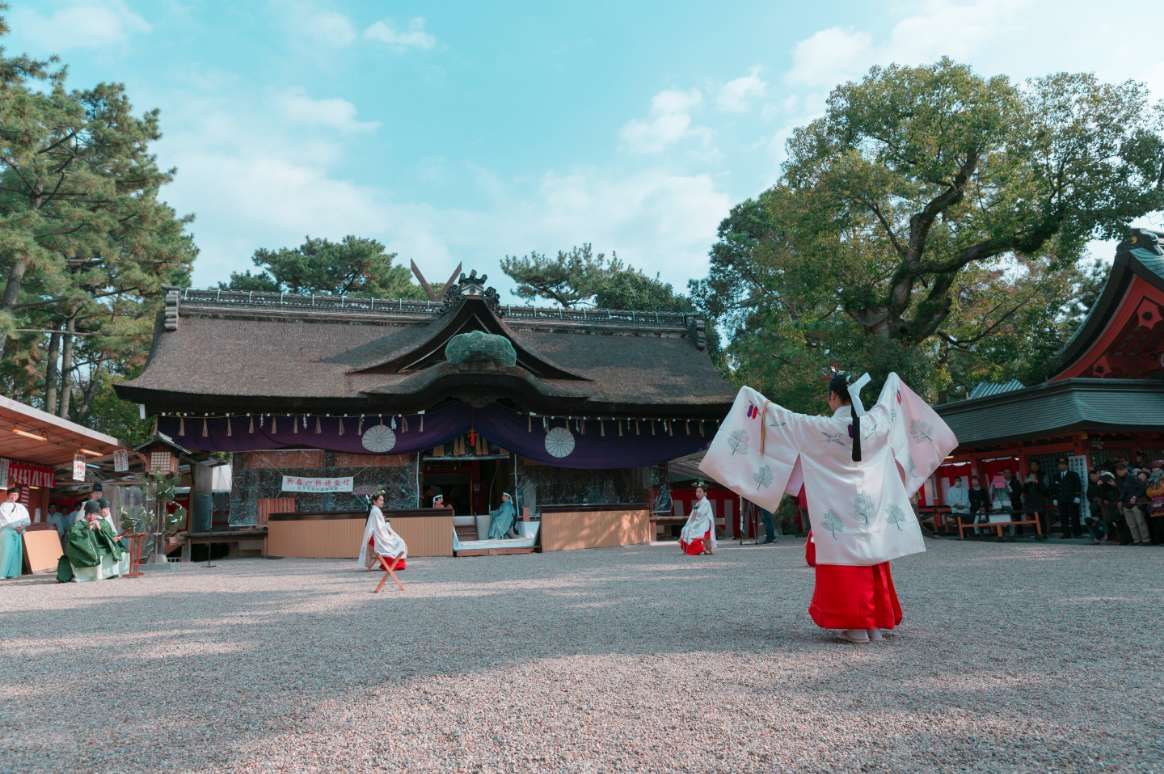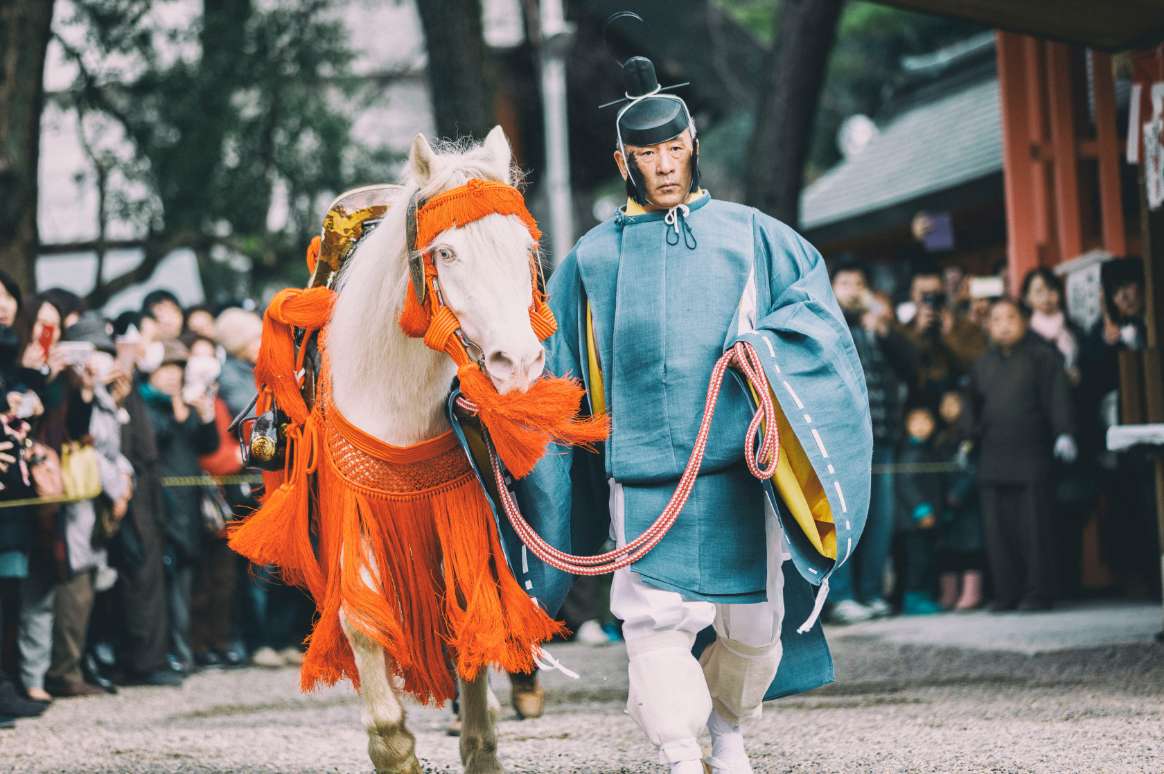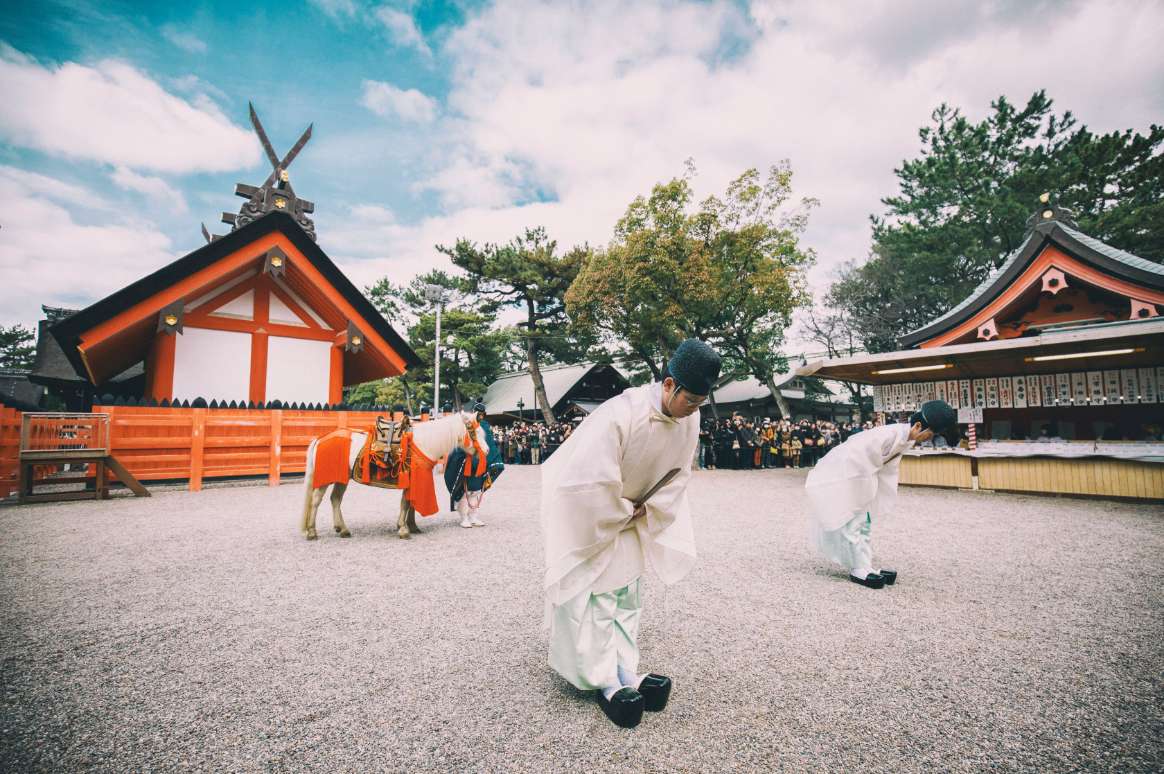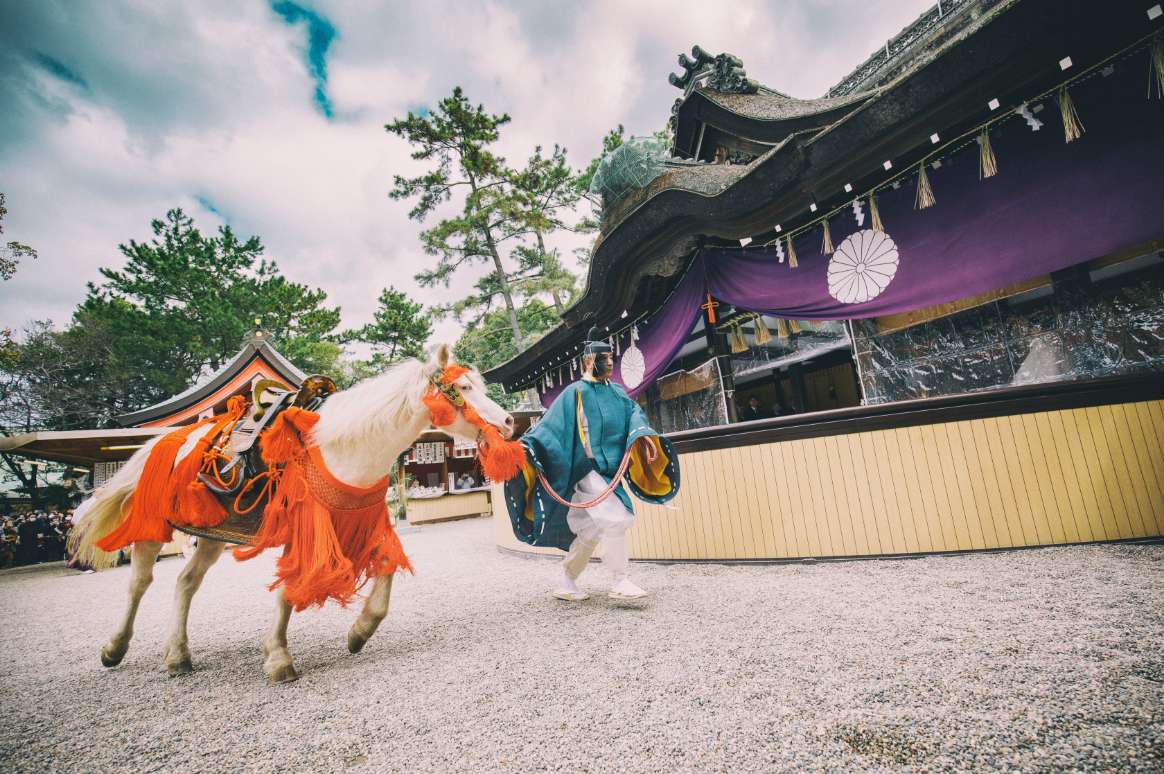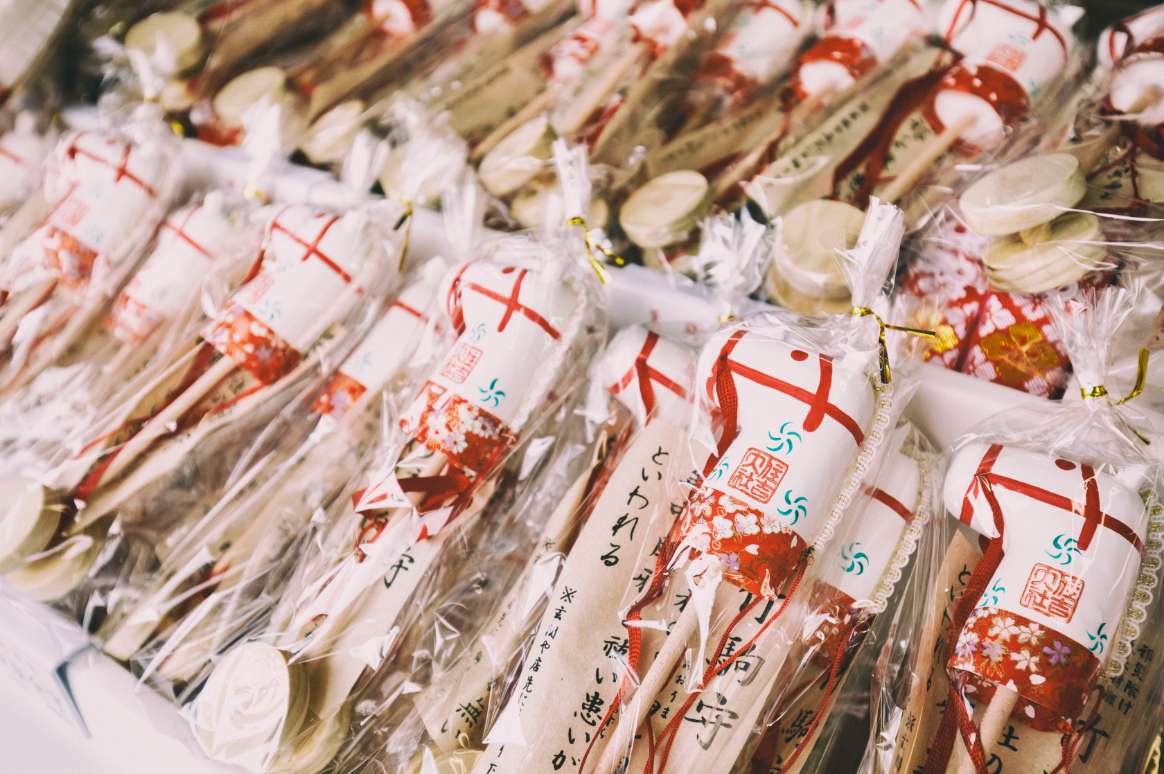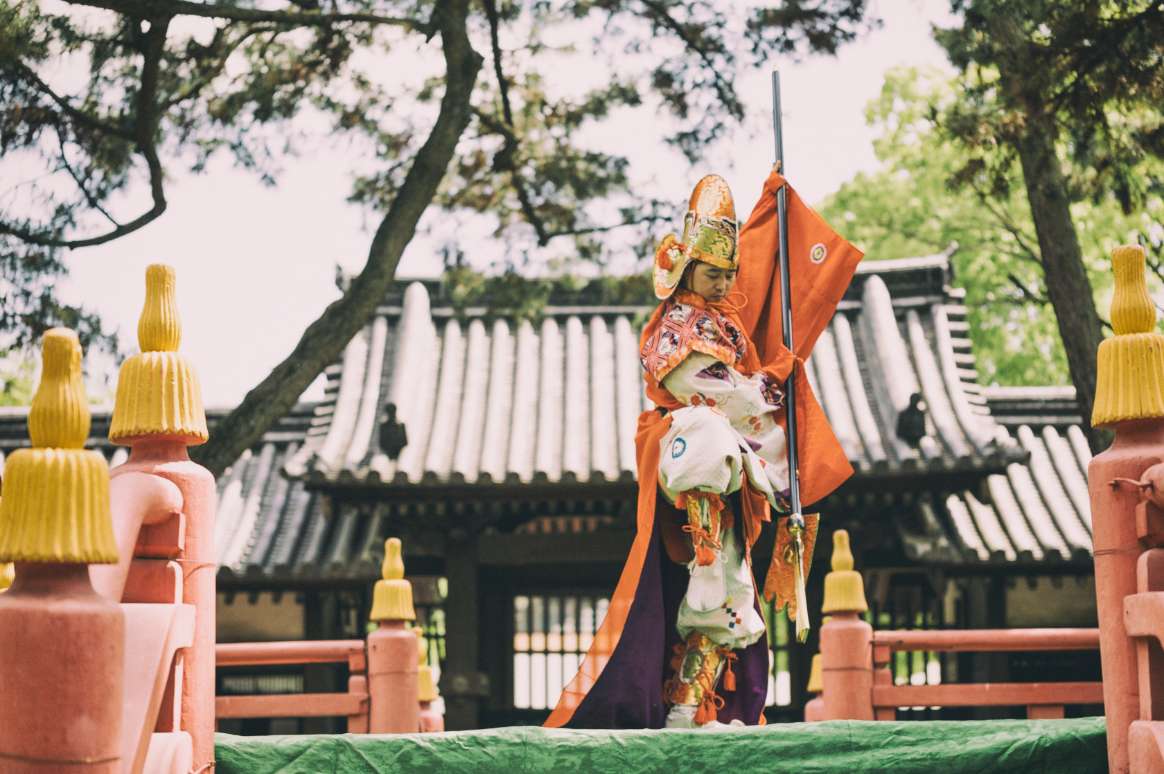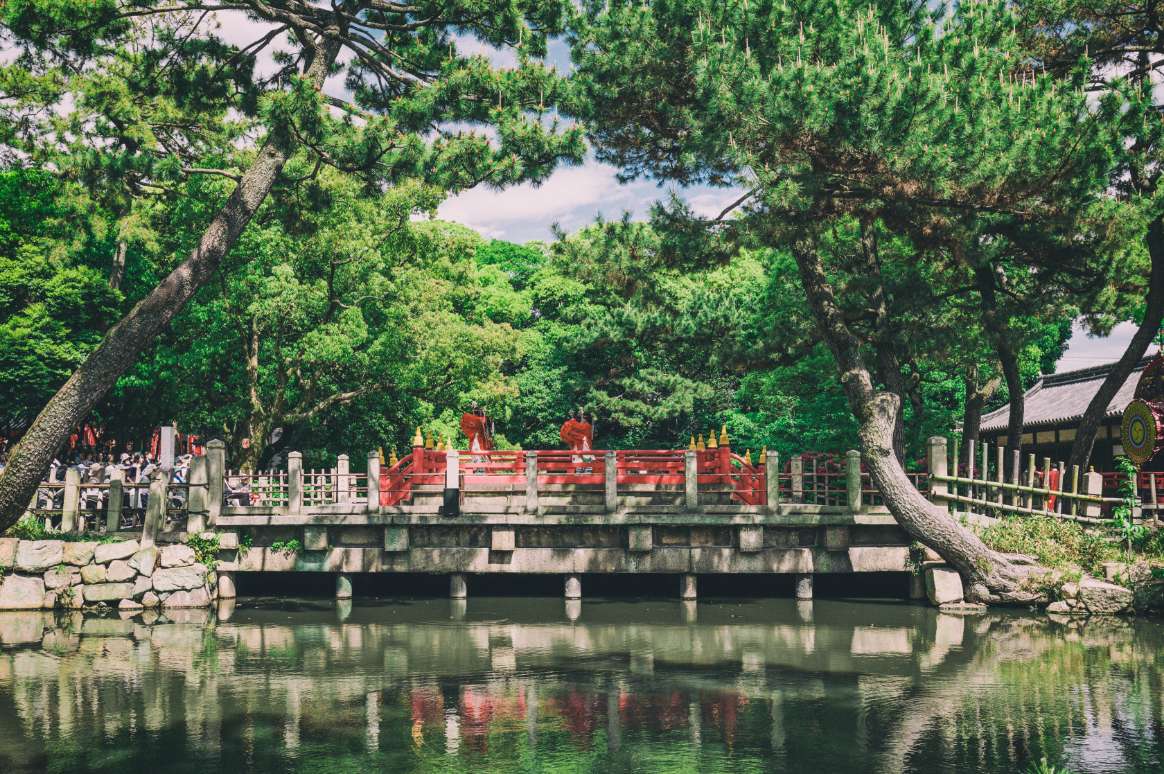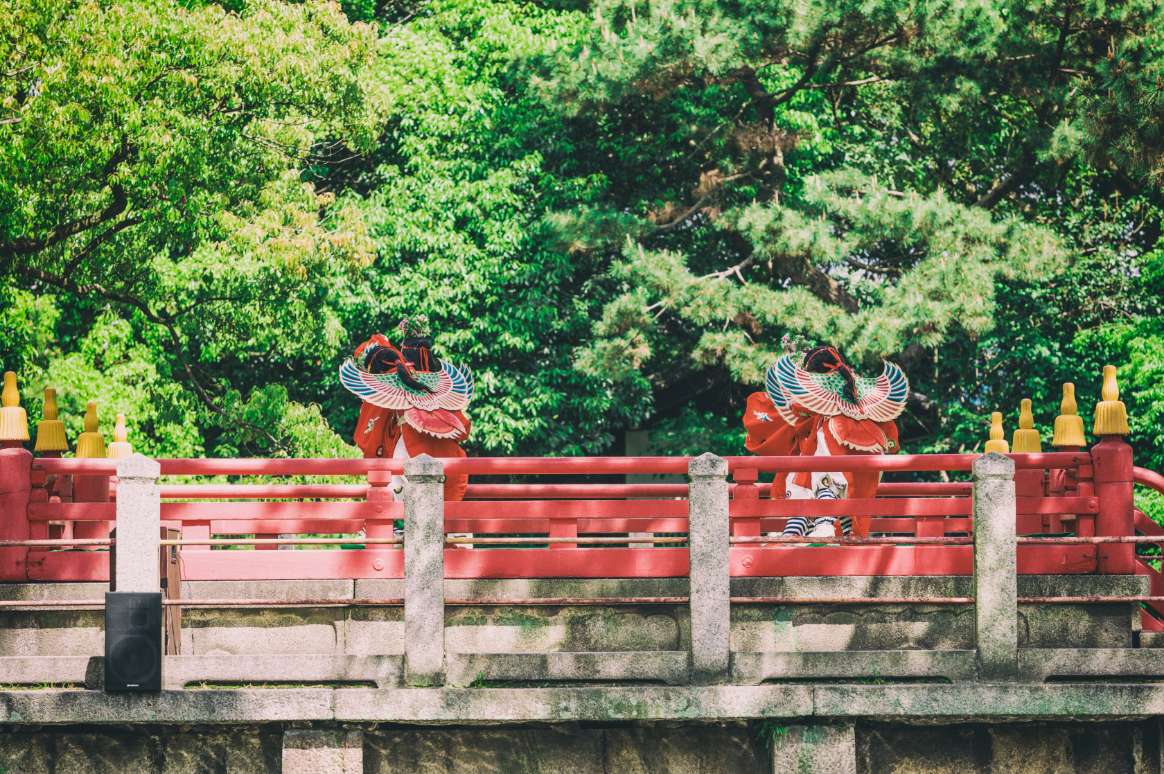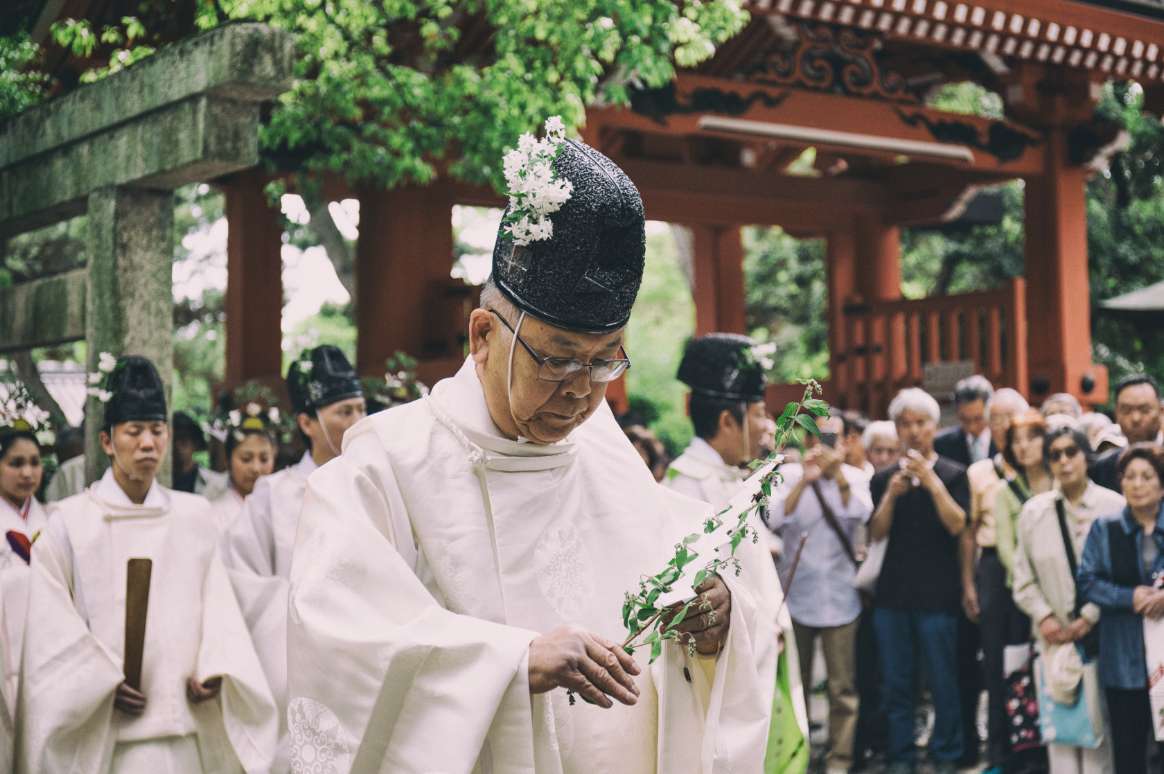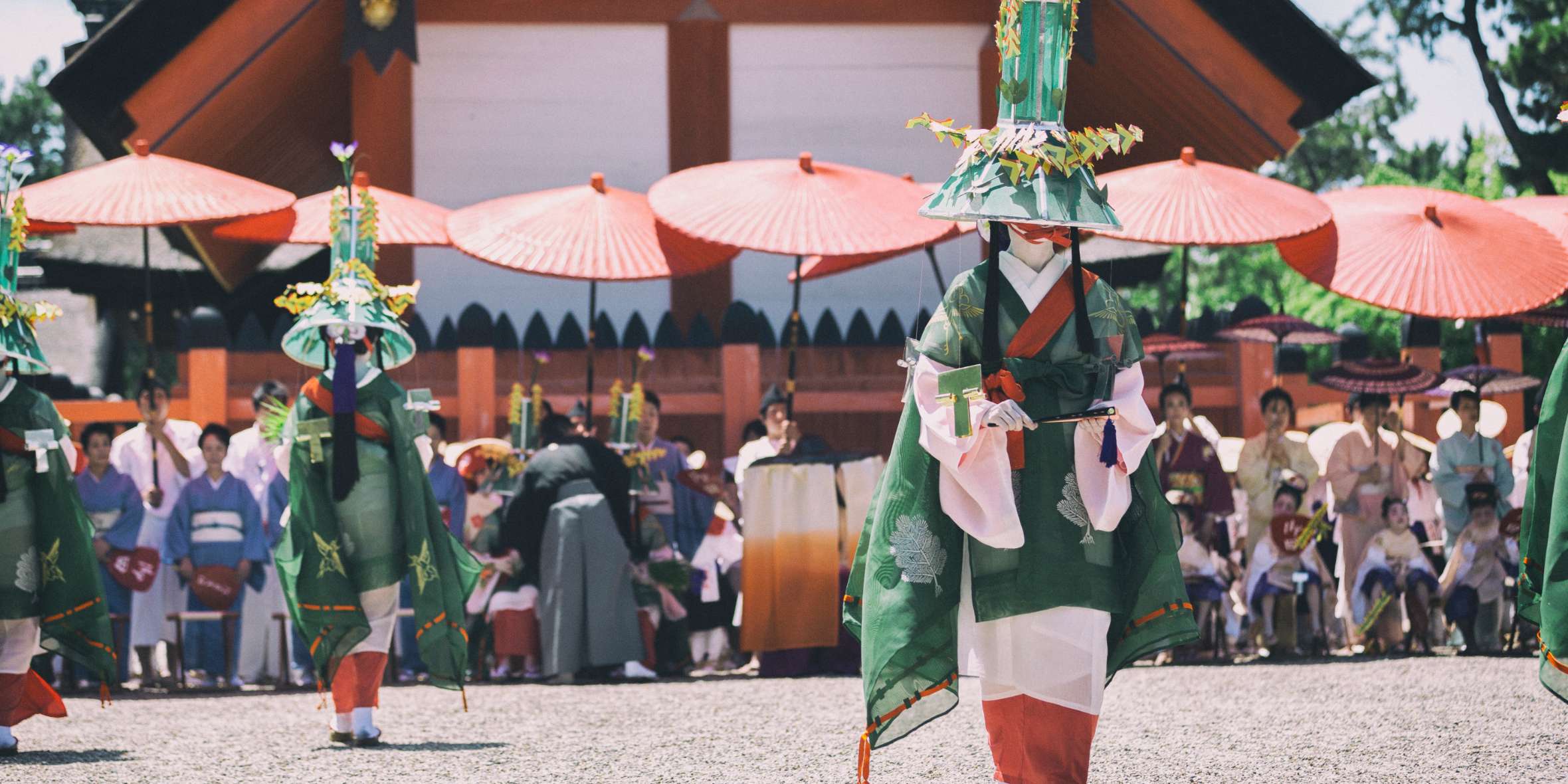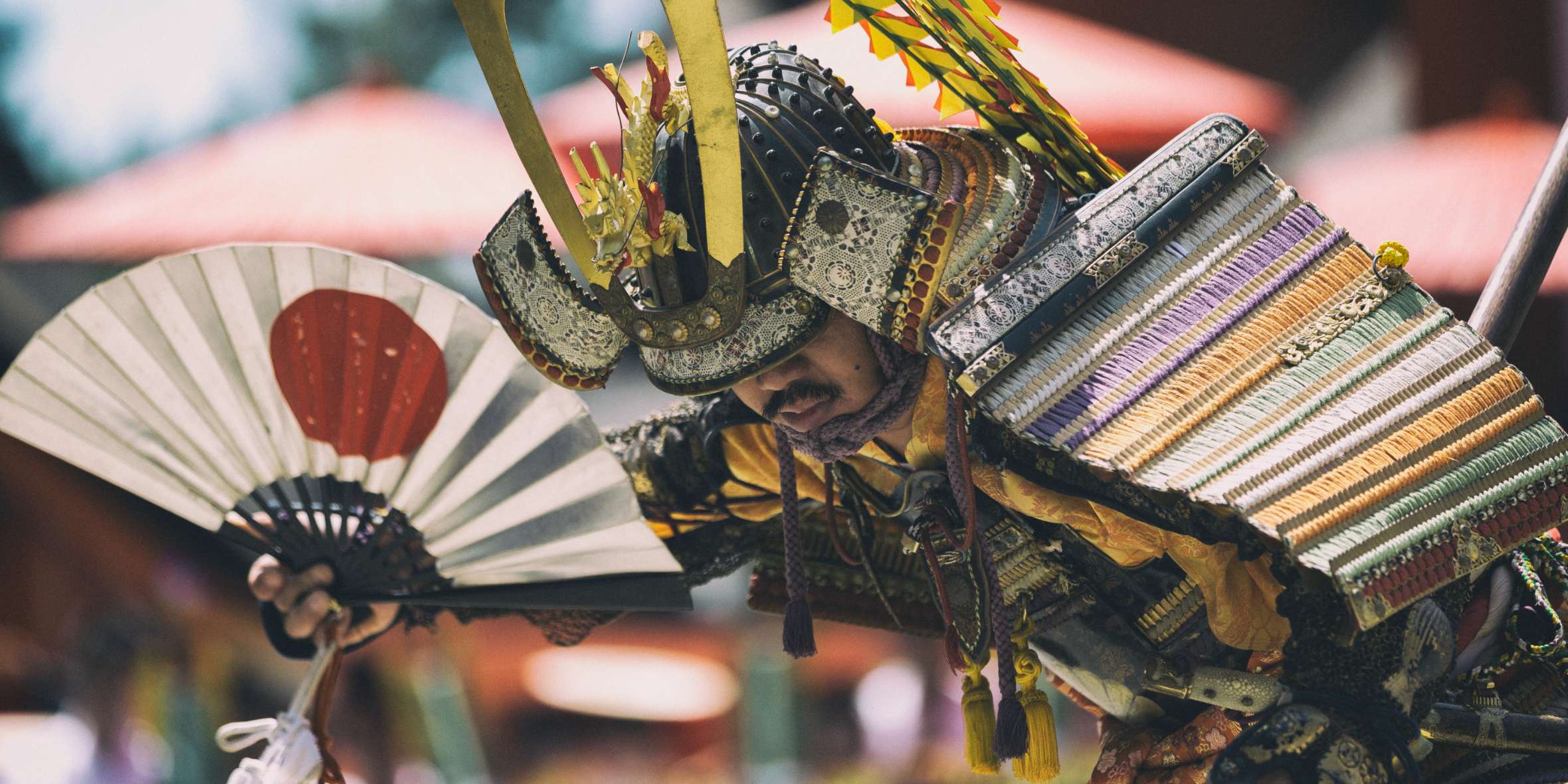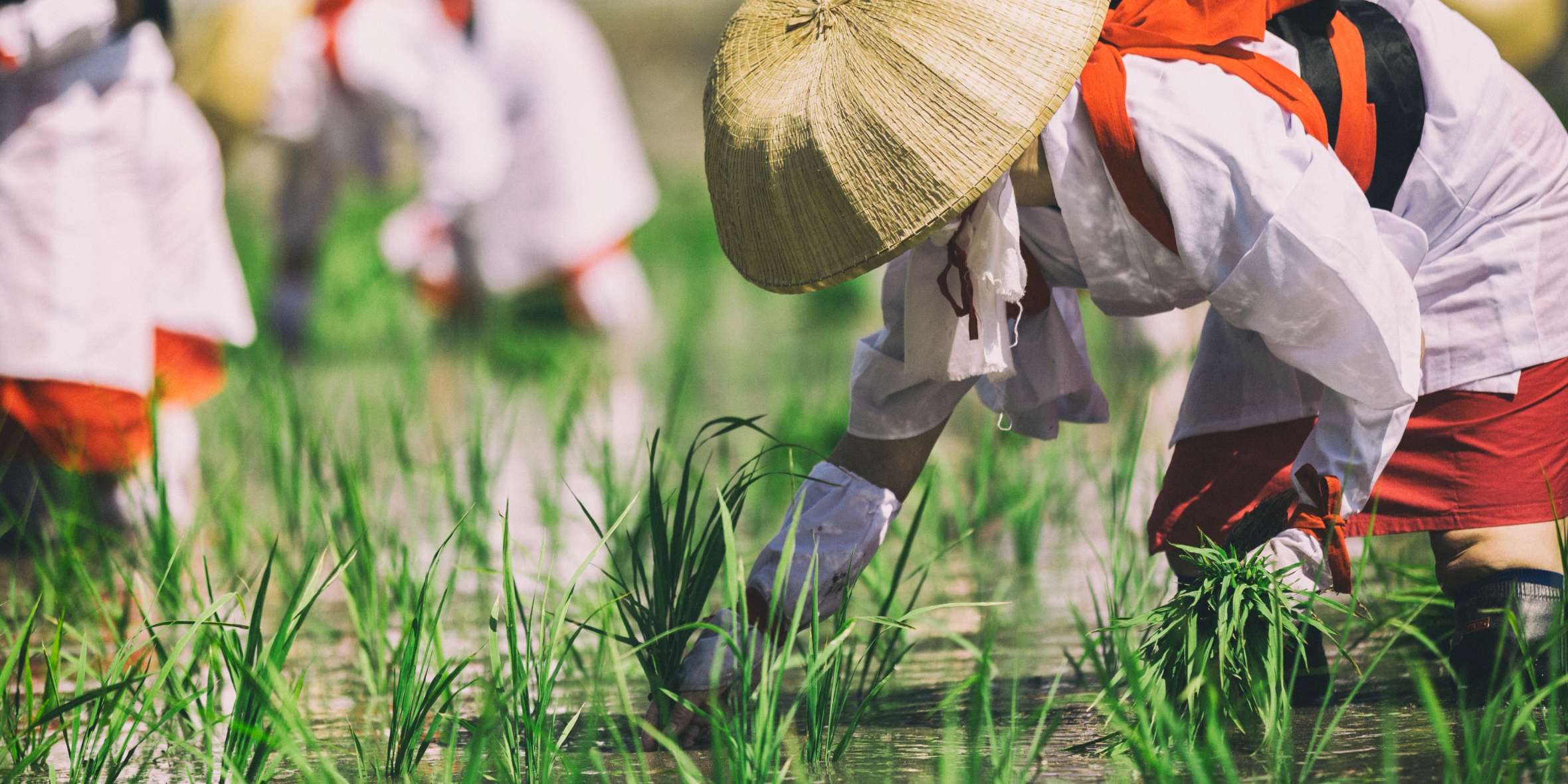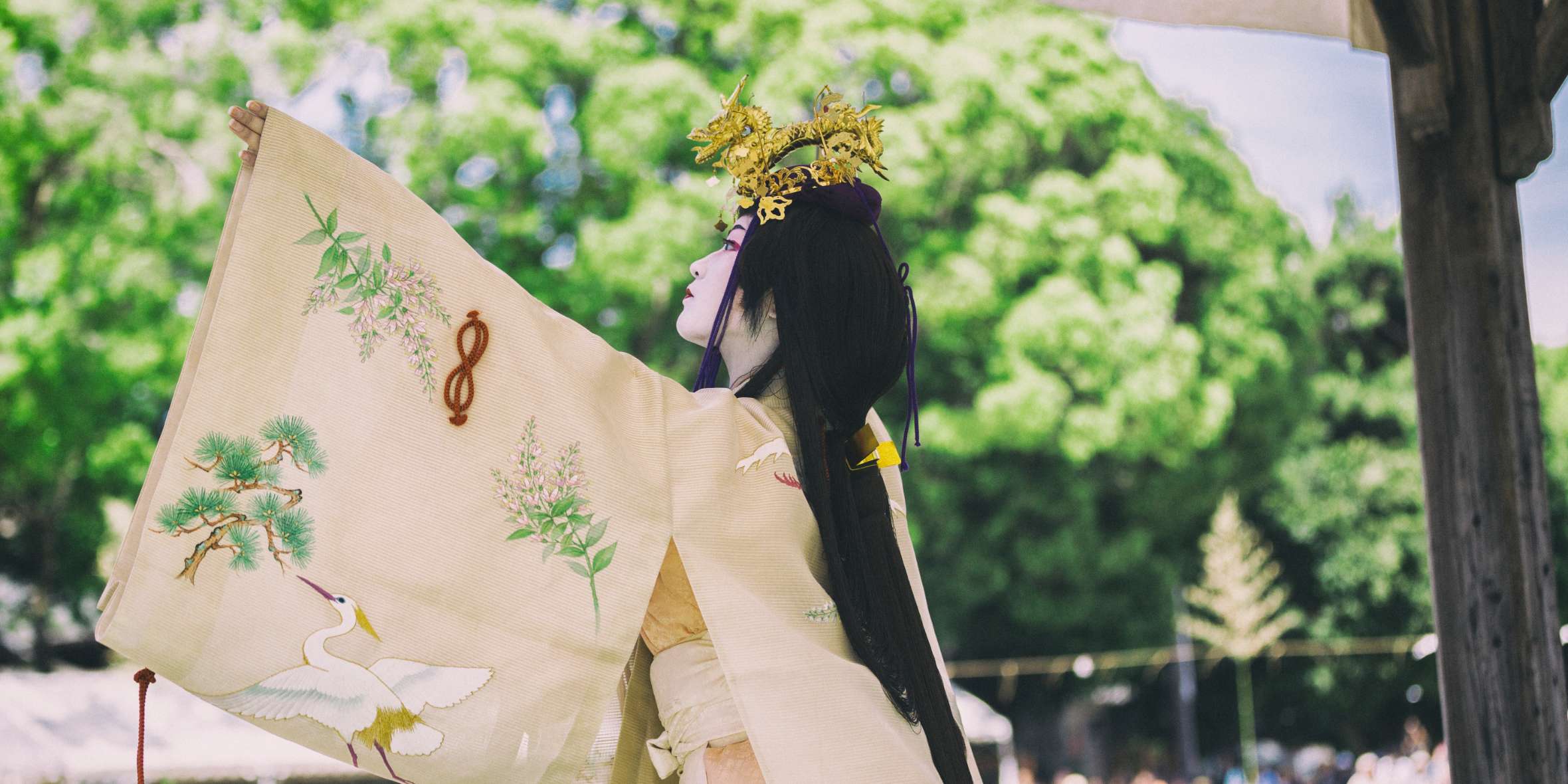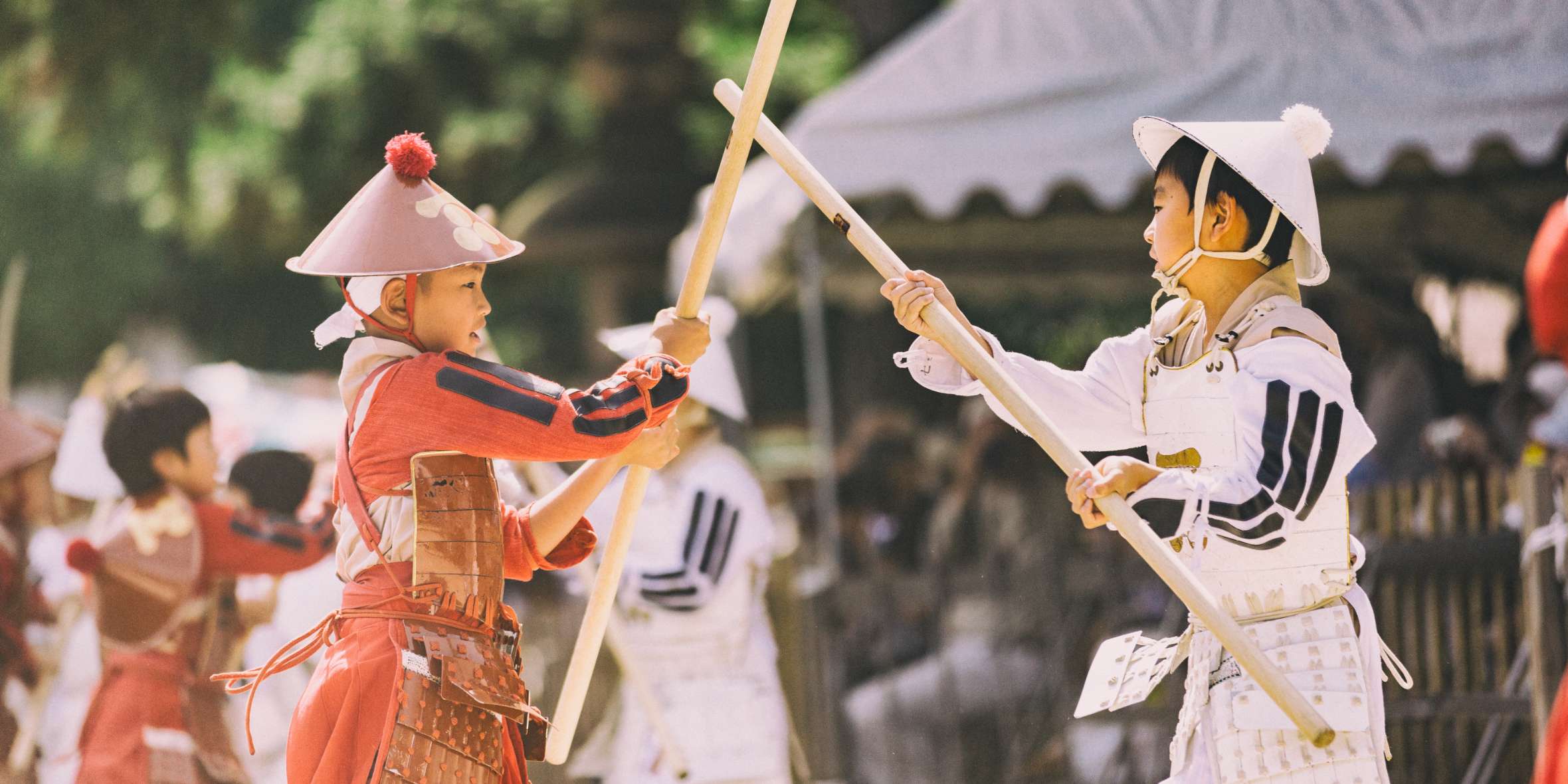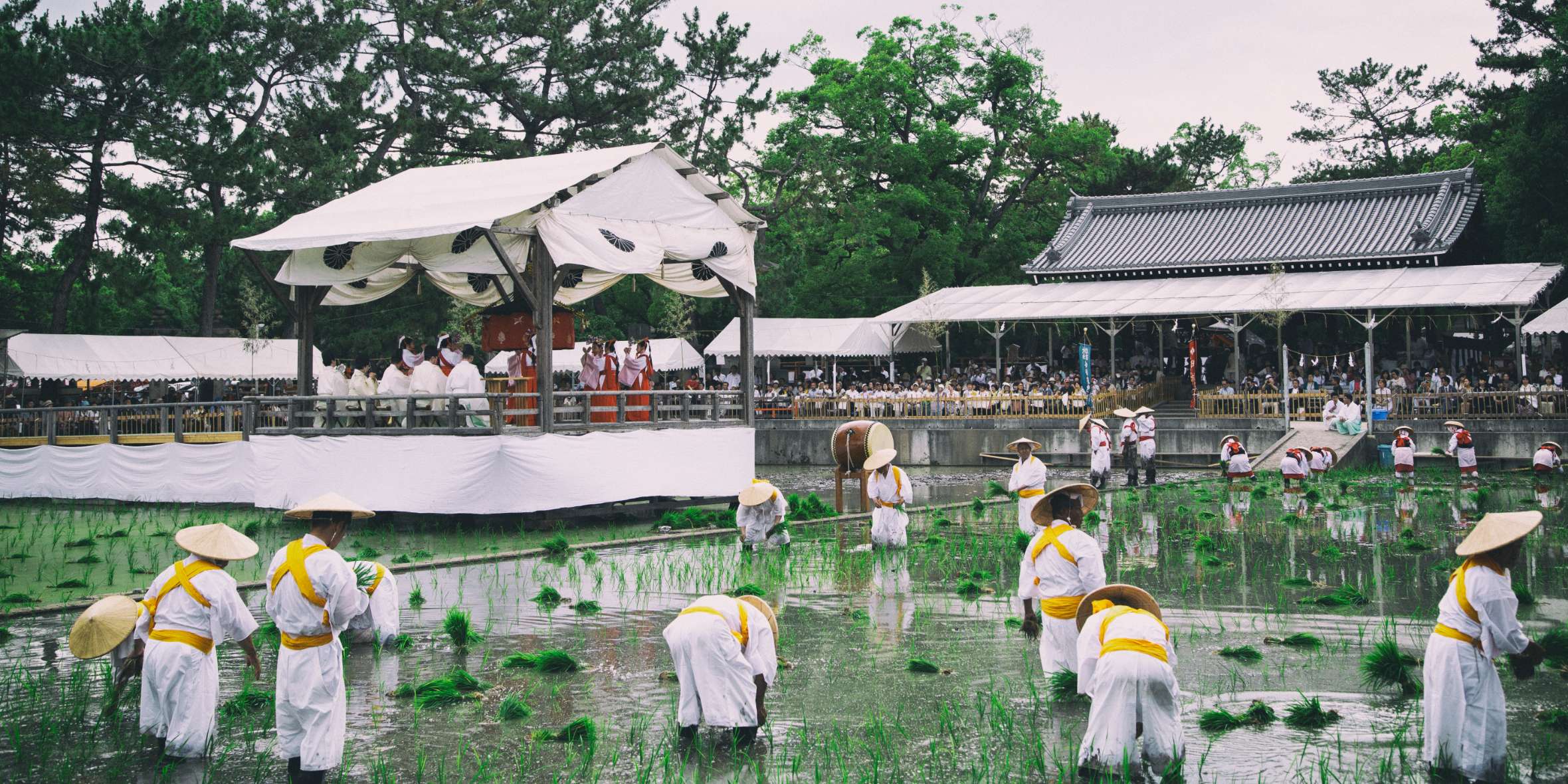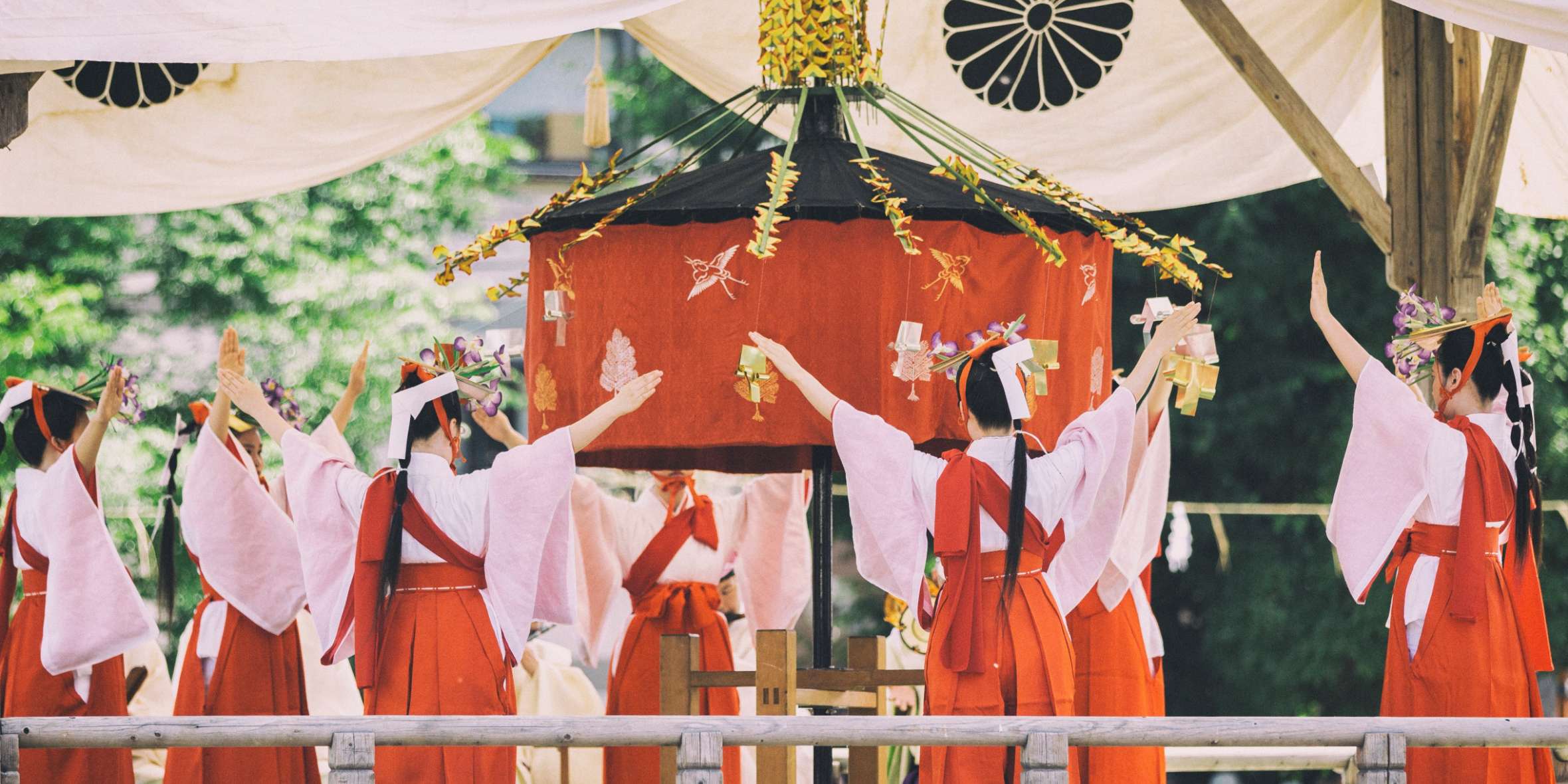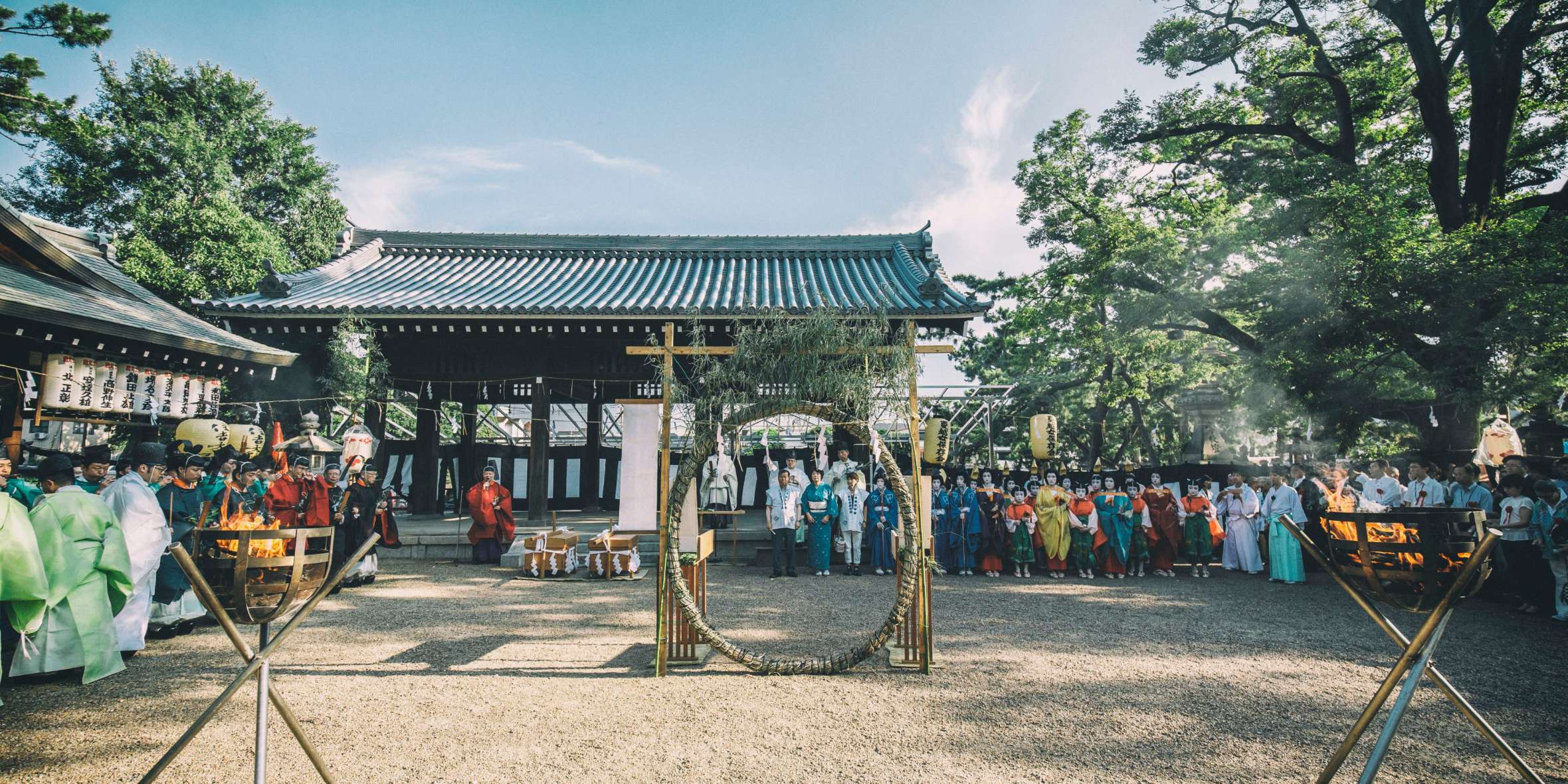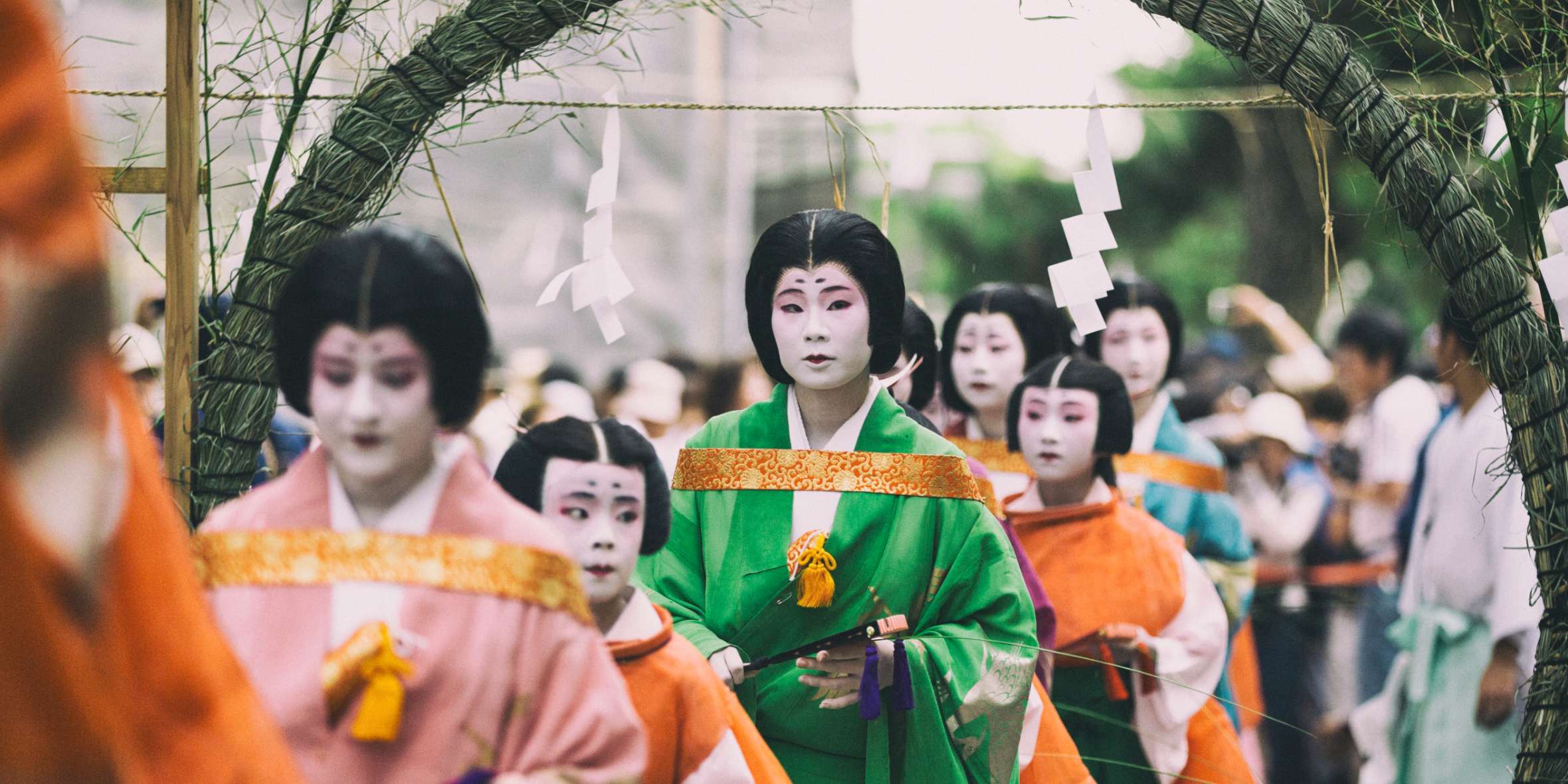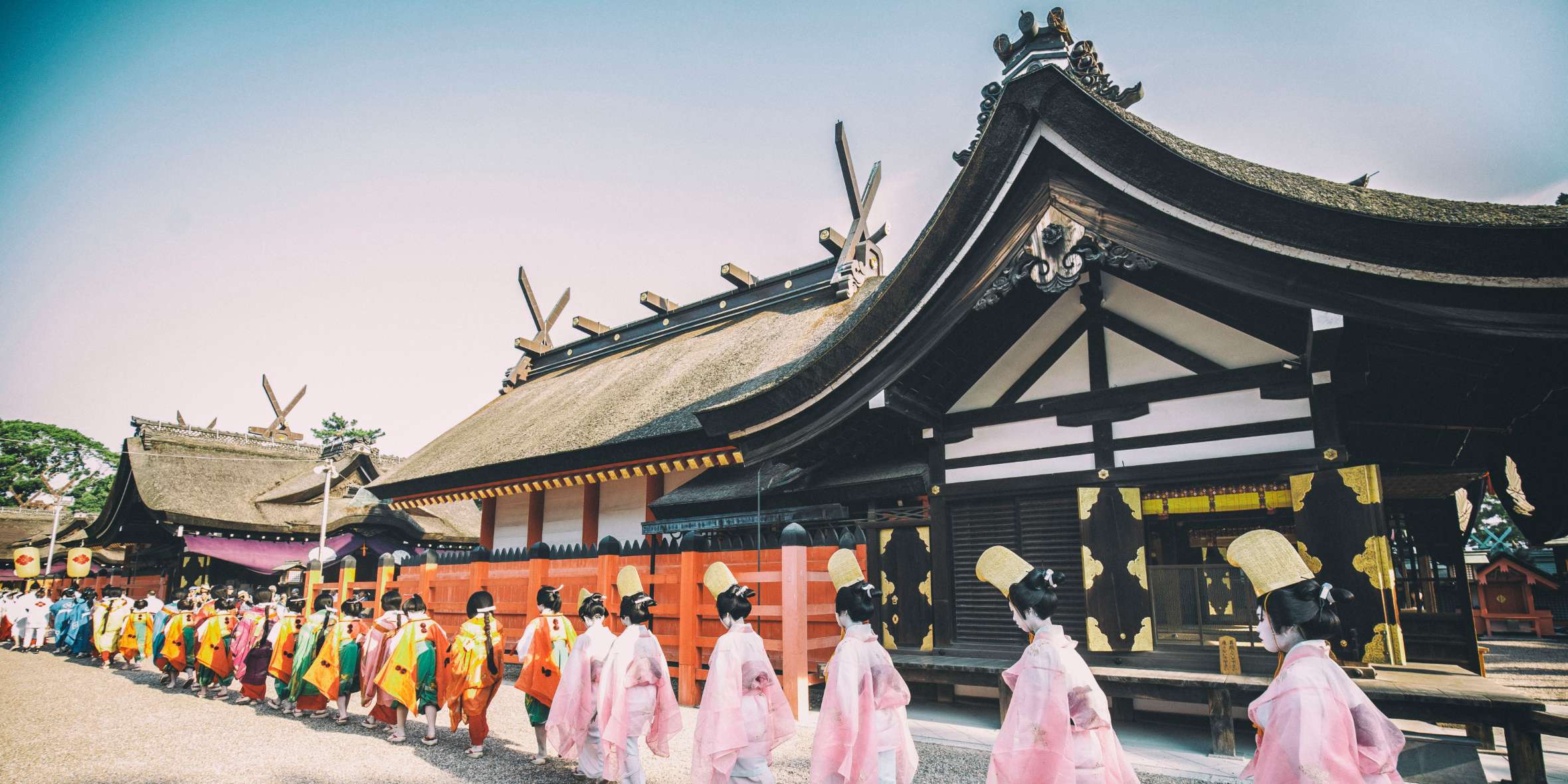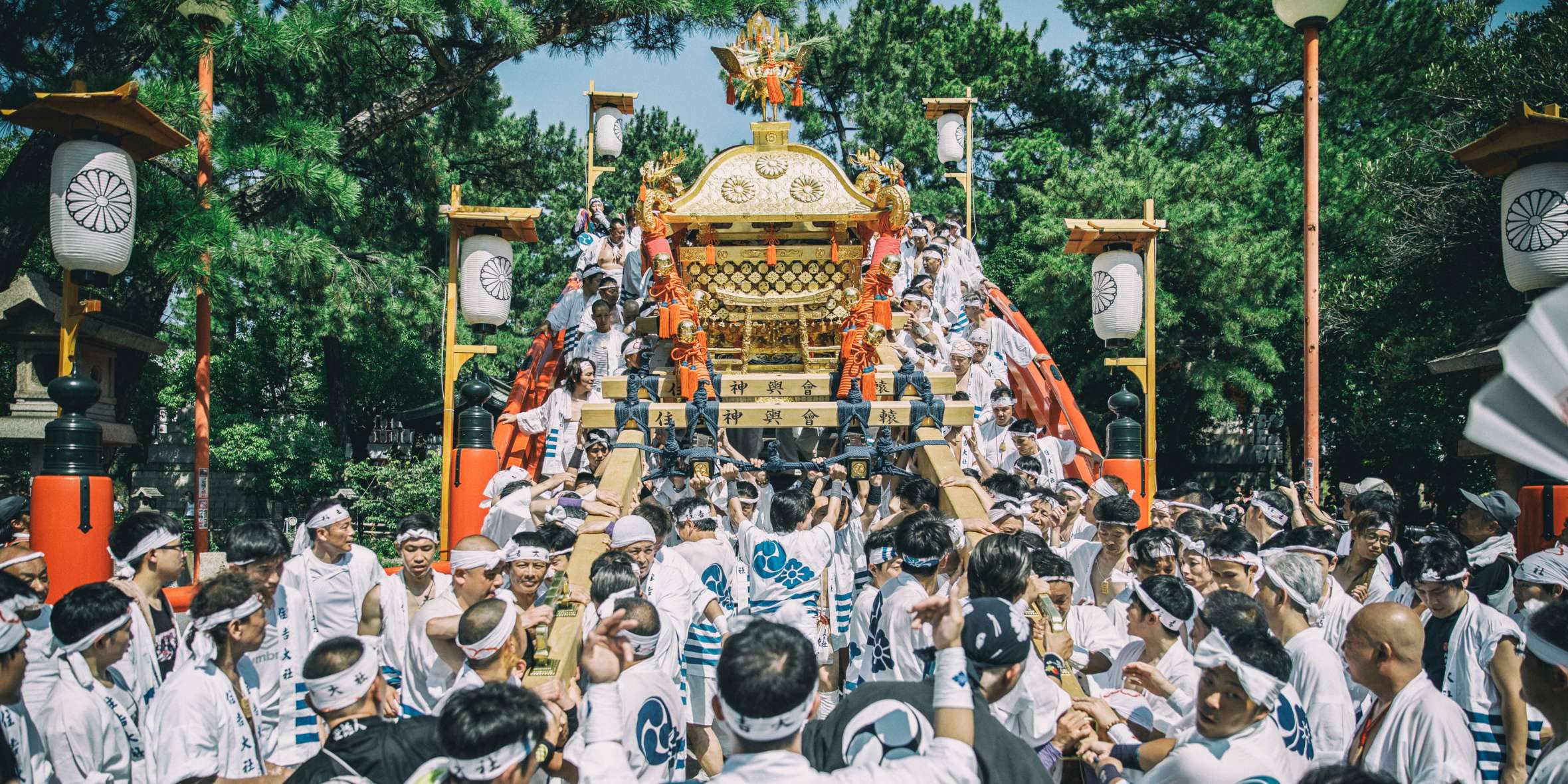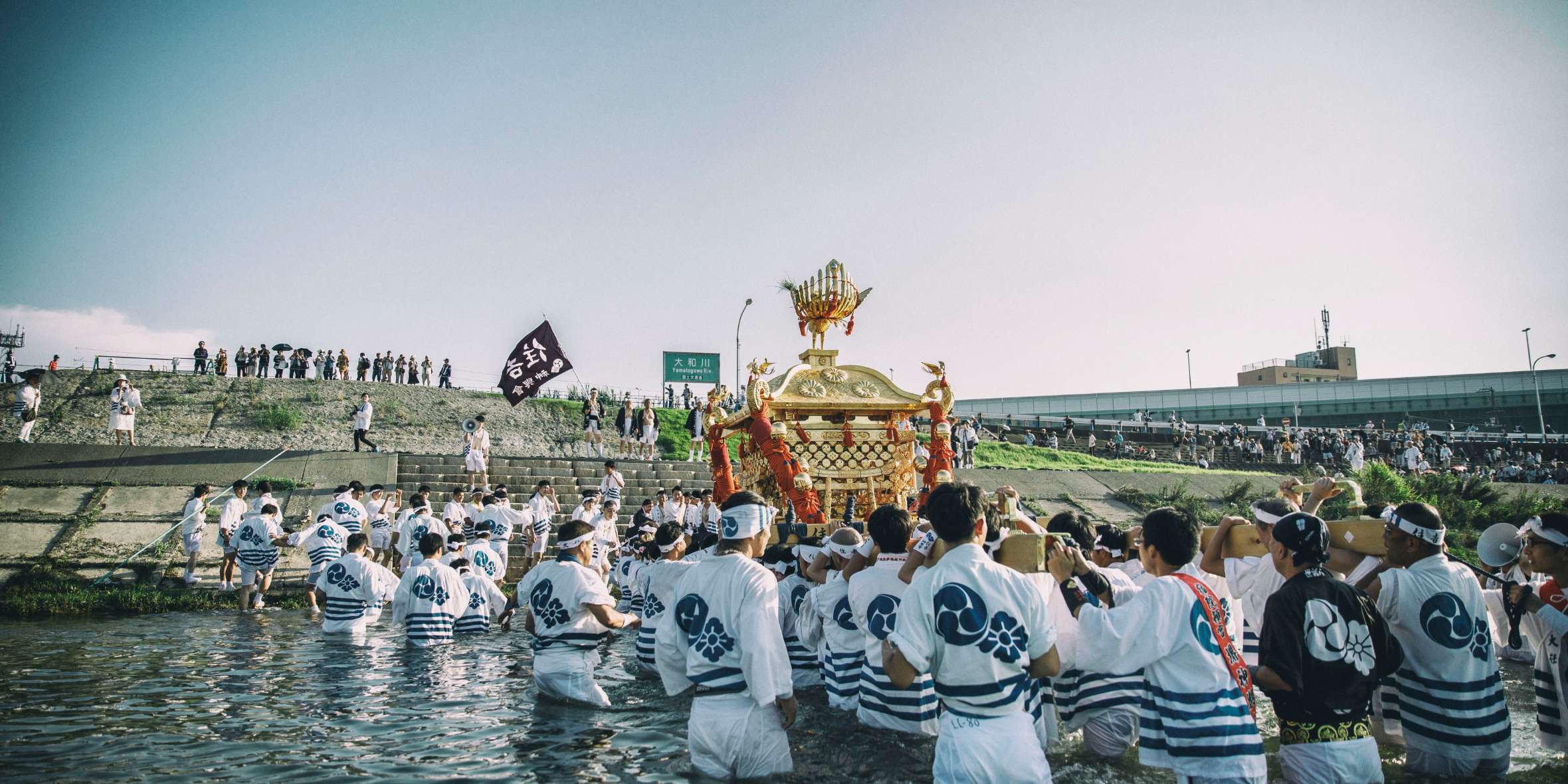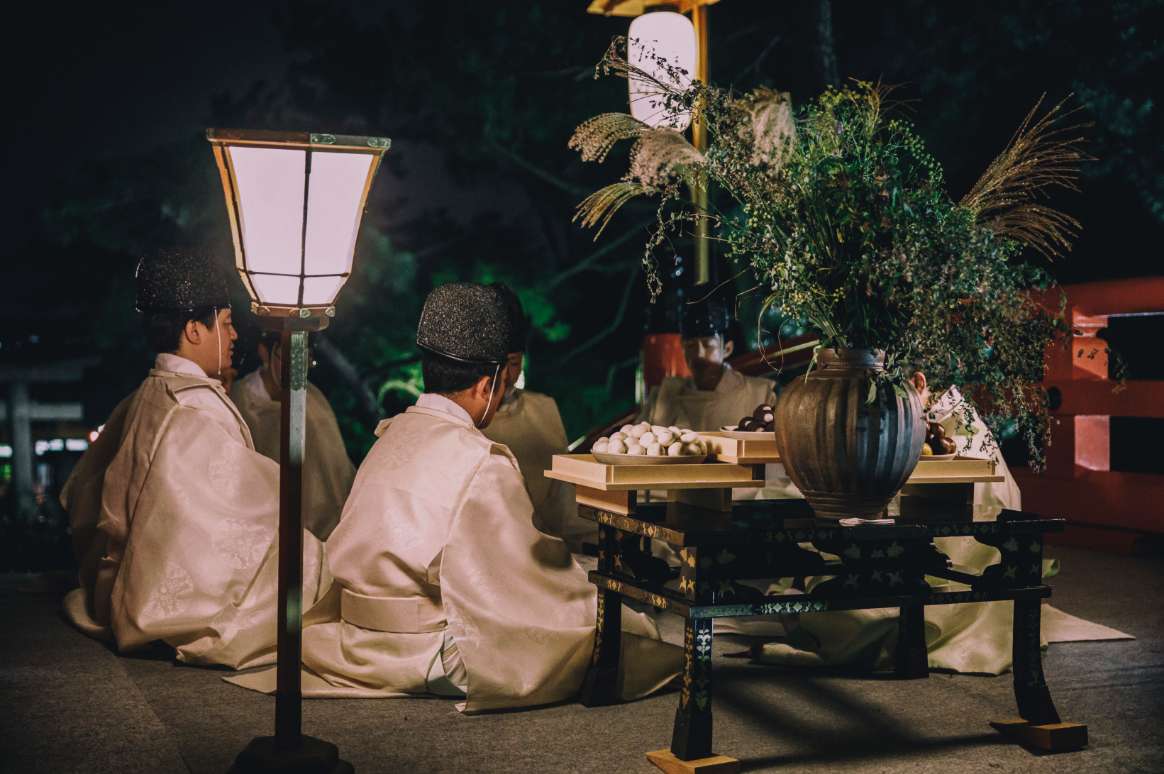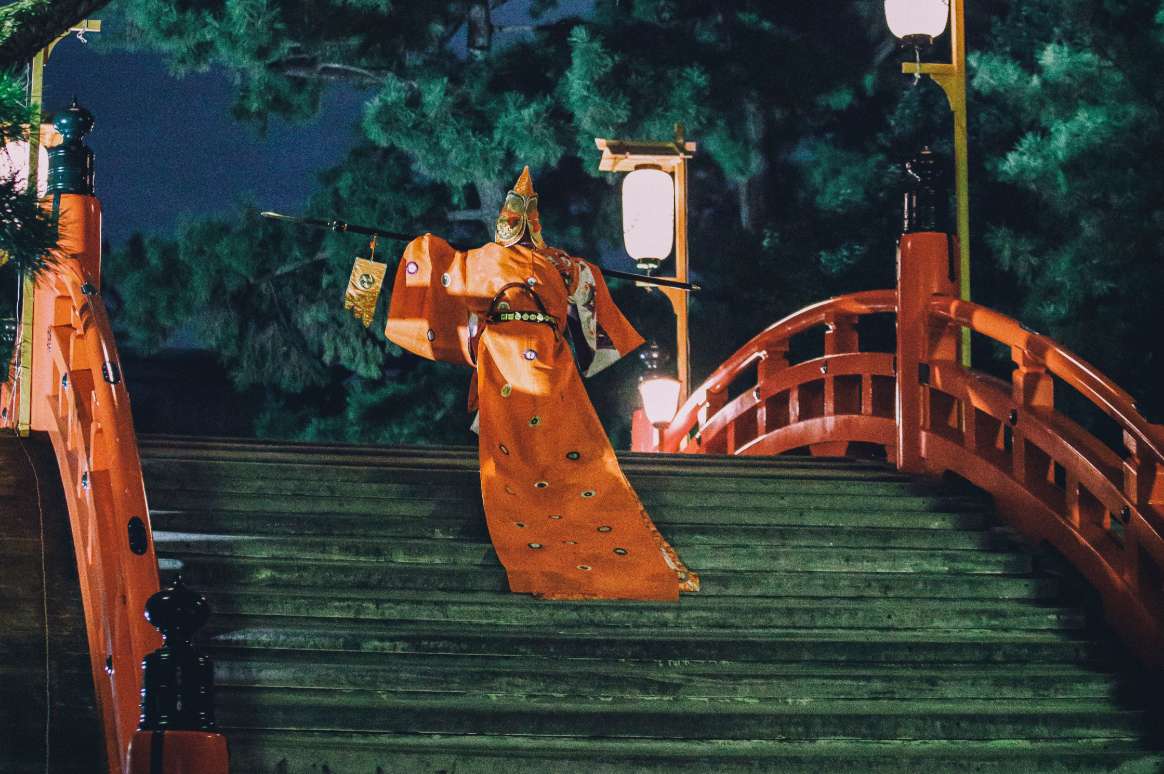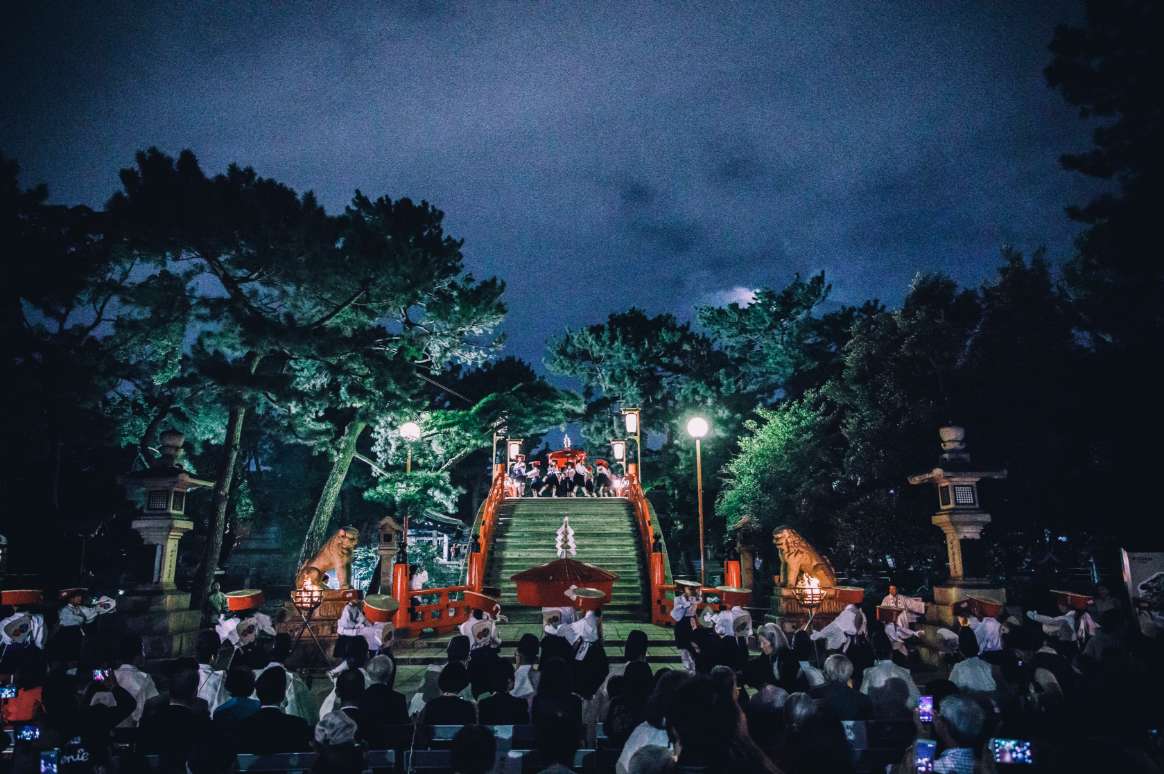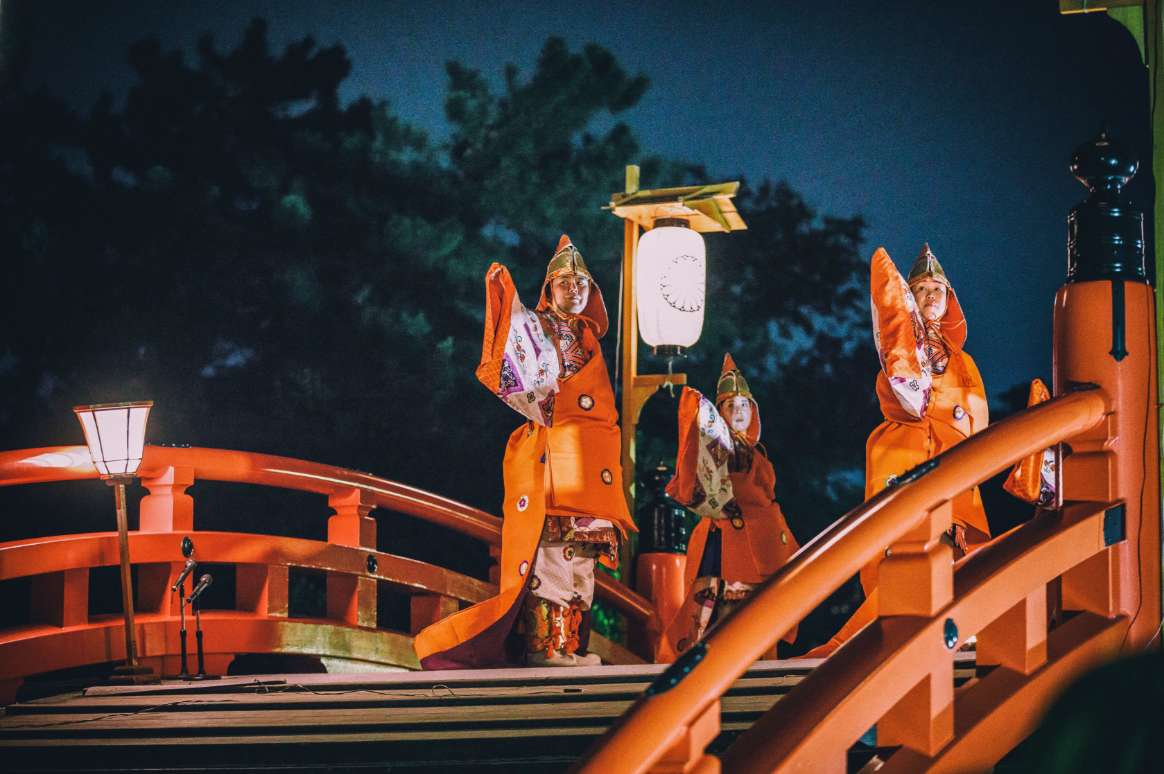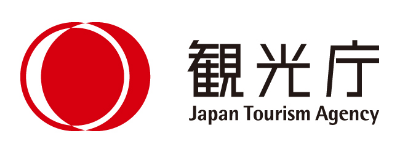Hatsumōde (New Year’s Shrine Visit)
January
“The year begins at Sumiyossan.” So says an old Osaka adage. Some two million people visit Sumiyoshi Taisha during the first three days of January for hatsumōde, the customary first Shinto shrine visit of the year.
Long lines form before midnight on New Year’s Eve as people wait to toss a coin in the offering box of Daiichi Hongū and say a short prayer for good fortune in the coming year. Vendors sell food and souvenirs from temporary stalls, creating a festive atmosphere, as people enjoy the brief New Year holidays and contemplate a fresh start. The crowds can be so dense that some worshippers throw their offerings over the heads of those in front—errant coins can be seen stuck between the shingles of the shrine’s roof.
The priests of Sumiyoshi Taisha perform a number of rituals to welcome the New Year. At 5 a.m. on New Year’s Day, they draw water from a sacred well and offer it to each of the shrine’s four patron gods, an act that symbolizes purification and renewal. Around an hour later, at sunrise, they pray for the safety and prosperity of the nation and for good harvests in the coming year.
Other events in early January include the Tōka Shinji on January 4, which features an ancient court ritual performed by two priests, as well as dances by shrine maidens called kagurame. On January 7, in the Ao-uma Shinji ritual, a white horse is brought to the shrine to drive off evil spirits.
Tōka Shinji
January 41 pm
The Tōka Shinji is an ancient New Year’s ritual with roots in China. It was performed at the imperial court during the Nara (710–794) and Heian (794–1185) periods and has been preserved in different forms at some Shinto shrines, notably Sumiyoshi Taisha and Atsuta Jingū in Nagoya.
The central rite is performed by two priests. One carries a plum branch and represents Ebisu, a god of wealth and patron of fishermen, while the other carries a bag of rice cakes and represents Daikokuten, another prosperity god who is seen as a patron of farmers. The priests begin by facing each other a short distance apart in front of Daiichi Hongū. They exchange greetings—a series of short call-and-response phrases—and take three steps forward each time until they have swapped places. (The word tōka combines the Chinese characters for “step” and “sing.”) The Daikokuten priest then presents his rice cakes to the Sumiyoshi Taisha deities.
In medieval times, a version of this stylized call-and-response ritual was taken up at secular celebrations, where it became known as senzu manzai. Regional variations developed, and manzai became a form of entertainment. Today, manzai refers to stand-up routines performed by pairs of comedians—a staple of Japanese show business, especially in Osaka.
Ao-uma Shinji (White Horse Rite)
January 711 am
The Ao-uma Shinji, or “white horse rite,” is a New Year’s purification ritual that takes place on January 7. In the past, many Shinto shrines kept white horses for ceremonial purposes, but today the practice is extremely rare. Sumiyoshi Taisha’s horse, Shirayuki, is normally stabled offsite, and is brought to the shrine for the Ao-uma Shinji.
During the rite, Shirayuki is led to each of the four main shrines, the buildings that house Sumiyoshi Taisha’s patron deities. The horse is then led in a circuit of the grounds. The ritual stems from a belief that white horses drive out evil spirits. According to tradition, anyone who sees Shirayuki at New Year will be protected from illness for the year.
Sumiyoshi Taisha is said to have kept white horses since the time of its founder, the legendary third-century empress-regent Jingū. According to tradition, Jingū brought the first horse back from the Korean peninsula after she led an invasion of the kingdoms there. The shrine’s horses are also connected to a number of legends and folk beliefs, including one that says eating three soybeans from Shirayuki’s fodder can cure teeth-grinding.
Unoha Shinji (Rabbit Flower Rite)
Early May1 pm
The Unoha Shinji is a festive rite commemorating Sumiyoshi Taisha’s founding. It takes place on the first “rabbit day” in May, which most closely corresponds to the “rabbit month” in the ancient Chinese calendar. Priests make offerings to the legendary empress-regent Jingū, who is said to have established Sumiyoshi Taisha. These include branches of Deutzia crenata, a plant of the hydrangea family called unohana, or “rabbit flower,” in Japanese.
The traditional Japanese time system was based on the ancient Chinese zodiac. Years, months, days, and nights were divided into 12 units named after animals. According to tradition, Sumiyoshi Taisha was founded on the first “rabbit day” of the “rabbit month” of 211, which was a “rabbit year.” Rabbits have been associated with the shrine ever since.
A highlight of the Unoha Shinji is traditional dancing performed on the shrine’s sixteenth-century stone stage.
Otaue Shinji (Sacred Rice Planting)
June 141 pm
Rice and religion are closely connected in Japan. In most places, the growing season starts and ends with Shinto rituals—ceremonial plantings to pray to the gods for the growth of rice seedlings and harvest festivals to thank the gods for the results. Sumiyoshi Taisha’s rice-planting rite, the Otaue Shinji, is among Japan’s best known. It has been faithfully preserved since ancient times.
The Otaue Shinji rite is said to date back to 211 when Sumiyoshi Taisha’s founder, the legendary empress-regent Jingū, ordered a new rice paddy to be created and dedicated to the shrine’s gods. She invited specially trained “planting maidens,” or ueme, from western Honshu to tend the field. The same paddy, just southwest of the main shrine area, is still used for the rite today.
The Otaue Shinji begins with a ritual for purifying the rice seedlings and the participants in the rite. The sacred paddy is tilled by oxen pulling a wooden plow, then sprinkled with consecrated water. As the ueme plant the rice, dancers and musicians in colorful costumes perform at the edges of the paddy. Their energy is said to imbue the seedlings with health and vigor.
During the Edo period (1603–1867), women from the travelers’ inns of nearby Sakai served as ueme. Many of these women, who were called yūjo, were skilled dancers and musicians, and the most accomplished were celebrities. In addition to planting rice, the yūjo would perform in the Otaue Shinji, receiving ritual purification through this display of their artistic talents. (Today, the role of ueme is taken by women in the performing arts from the Osaka area.)
The Otaue Shinji takes place every year on June 14. The government has designated it an Important Intangible Cultural Folk Asset.
Sumiyoshi Matsuri Festival
July 30 - August 1
The Sumiyoshi Matsuri is one of Osaka’s largest summer festivals. It is held every year from July 30 to August 1. It is also called the Oharae, meaning “purification,” because its ceremonies ward off disease and other misfortunes. Before the festival begins, the portable shrines, or mikoshi, which are used to carry the deities, are cleansed. The water for this task is drawn from Osaka Bay in the early hours of the morning.
On July 30 at 8:00 p.m., the Yoimiyasai ceremony is held to transfer the deities to the mikoshi. The Nagoshi no Harae Shinji, or “summer purification ceremony,” is performed the following day. The ceremony consists of a procession that includes shrine maidens, children, and dancers dressed in colorful Muromachi period (1336–1573) costumes. They pass through huge standing rings made of plaited grass, which is considered spiritually cleansing.
Kangetsu-sai (Moon-Viewing Festival)
Around September and October(Dates vary by year in accordance with the Harvest Moon)
The Kangetsu-sai, or “moon-viewing festival,” takes place under a full moon in autumn, usually in mid- to late September. Its central attraction, aside from the glowing moon itself, is poetry: the festival celebrates traditional Japanese poetic forms, specifically tanka and haiku.
Tanka are poems with fixed numbers of lines and syllables, following a pattern of 5-7-5-7-7, (haiku dispenses with the last two lines). At the Kangetsu-sai, priests read selected poems aloud from the top of Sorihashi, the famed arched bridge. Amateur poets can submit work for consideration. The readings are followed by performances of traditional dancing.
Sumiyoshi Taisha’s association with poetry goes back more than a thousand years. References to the shrine and its coastal setting are found in poems from the eighth and ninth centuries, including those in the Man’yōshū, Japan’s oldest surviving poetry collection. The shrine’s gods were seen as protectors and muses. According to one legend, when the famous poet Fujiwara no Teika (1162–1241) spent a night at the shrine, the gods appeared to him in a dream in the form of an old man. Their words to him, “the moon is bright,” inspired the title of his diary, Chronicle of the Bright Moon.


